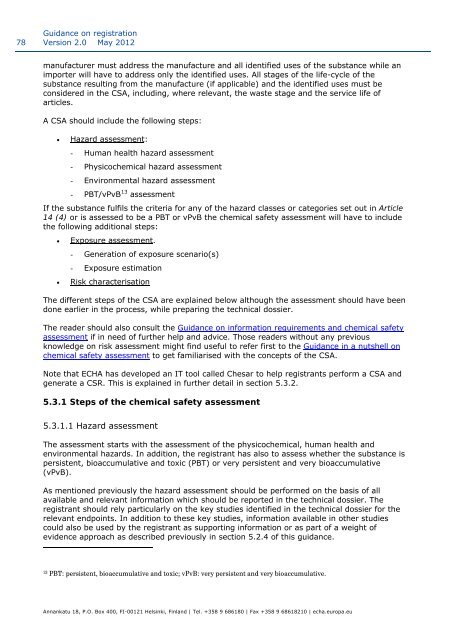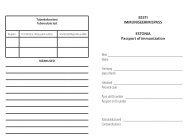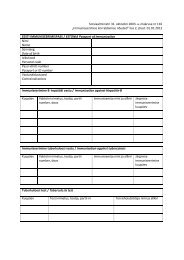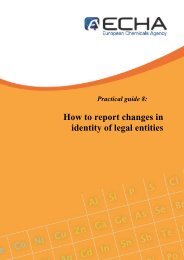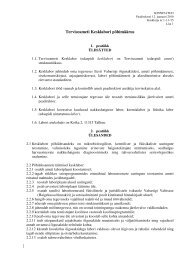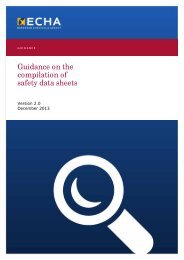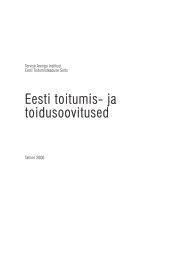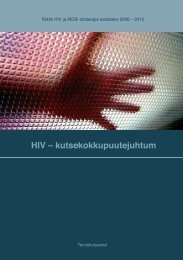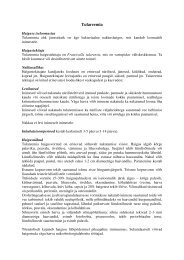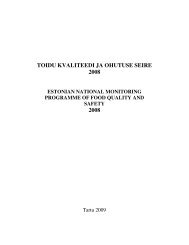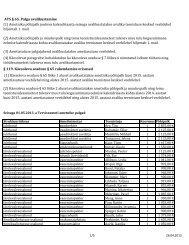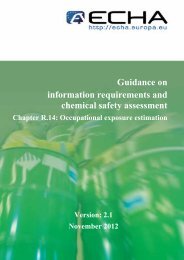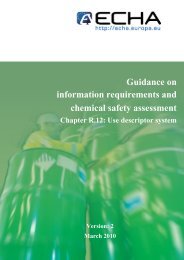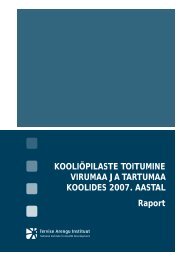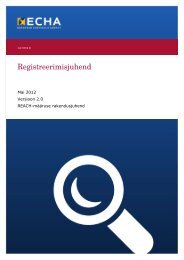Guidance on registration - ECHA - Europa
Guidance on registration - ECHA - Europa
Guidance on registration - ECHA - Europa
Create successful ePaper yourself
Turn your PDF publications into a flip-book with our unique Google optimized e-Paper software.
78<br />
<str<strong>on</strong>g>Guidance</str<strong>on</strong>g> <strong>on</strong> registrati<strong>on</strong><br />
Versi<strong>on</strong> 2.0 May 2012<br />
manufacturer must address the manufacture and all identified uses of the substance while an<br />
importer will have to address <strong>on</strong>ly the identified uses. All stages of the life-cycle of the<br />
substance resulting from the manufacture (if applicable) and the identified uses must be<br />
c<strong>on</strong>sidered in the CSA, including, where relevant, the waste stage and the service life of<br />
articles.<br />
A CSA should include the following steps:<br />
Hazard assessment:<br />
- Human health hazard assessment<br />
- Physicochemical hazard assessment<br />
- Envir<strong>on</strong>mental hazard assessment<br />
- PBT/vPvB 13 assessment<br />
If the substance fulfils the criteria for any of the hazard classes or categories set out in Article<br />
14 (4) or is assessed to be a PBT or vPvB the chemical safety assessment will have to include<br />
the following additi<strong>on</strong>al steps:<br />
Exposure assessment.<br />
- Generati<strong>on</strong> of exposure scenario(s)<br />
- Exposure estimati<strong>on</strong><br />
Risk characterisati<strong>on</strong><br />
The different steps of the CSA are explained below although the assessment should have been<br />
d<strong>on</strong>e earlier in the process, while preparing the technical dossier.<br />
The reader should also c<strong>on</strong>sult the <str<strong>on</strong>g>Guidance</str<strong>on</strong>g> <strong>on</strong> informati<strong>on</strong> requirements and chemical safety<br />
assessment if in need of further help and advice. Those readers without any previous<br />
knowledge <strong>on</strong> risk assessment might find useful to refer first to the <str<strong>on</strong>g>Guidance</str<strong>on</strong>g> in a nutshell <strong>on</strong><br />
chemical safety assessment to get familiarised with the c<strong>on</strong>cepts of the CSA.<br />
Note that <strong>ECHA</strong> has developed an IT tool called Chesar to help registrants perform a CSA and<br />
generate a CSR. This is explained in further detail in secti<strong>on</strong> 5.3.2.<br />
5.3.1 Steps of the chemical safety assessment<br />
5.3.1.1 Hazard assessment<br />
The assessment starts with the assessment of the physicochemical, human health and<br />
envir<strong>on</strong>mental hazards. In additi<strong>on</strong>, the registrant has also to assess whether the substance is<br />
persistent, bioaccumulative and toxic (PBT) or very persistent and very bioaccumulative<br />
(vPvB).<br />
As menti<strong>on</strong>ed previously the hazard assessment should be performed <strong>on</strong> the basis of all<br />
available and relevant informati<strong>on</strong> which should be reported in the technical dossier. The<br />
registrant should rely particularly <strong>on</strong> the key studies identified in the technical dossier for the<br />
relevant endpoints. In additi<strong>on</strong> to these key studies, informati<strong>on</strong> available in other studies<br />
could also be used by the registrant as supporting informati<strong>on</strong> or as part of a weight of<br />
evidence approach as described previously in secti<strong>on</strong> 5.2.4 of this guidance.<br />
13<br />
PBT: persistent, bioaccumulative and toxic; vPvB: very persistent and very bioaccumulative.<br />
Annankatu 18, P.O. Box 400, FI-00121 Helsinki, Finland | Tel. +358 9 686180 | Fax +358 9 68618210 | echa.europa.eu


